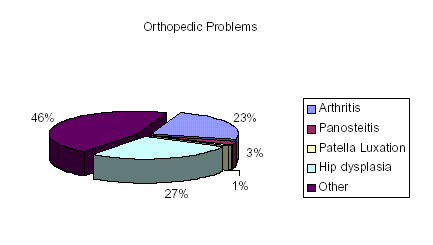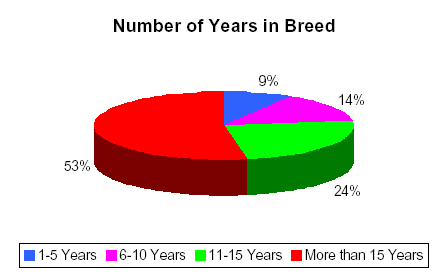|
Summary: So Many
Diseases, So Little Time
If an individual has
spent his life with Samoyeds, as has your analyst, he begins to feel that he has seen at least
one case of everything that can go wrong with the breed. Luckily, that is not so. Analysis
of the raw data of the survey shows heart-wrenching problems that have befallen the
respondents … and some possible humor.
A respondent of the
survey self-diagnosed a Dermatology problem of gingivitis. You have to remember to brush
those Sams teeth after meals. A notable exception in the gastro- area was that no one
mentioned a problem with Sams having gas, a somewhat famous problem with certain other
breeds such as the Bulldog. One takes one’s satisfactions where they can be found.
But, the
heart-wrenching problem areas are very real and very disturbing. The
"other" category in cancer,
some nineteen incidents, has to give one pause. Your analyst witnessed a favorite old dog
die of a rhinosarcoma, a cancerous tumor embedded in an inoperable portion of the dogs
muzzle ... the dog sneezing was a literal bloody disaster. As is true in humans, the only
available treatments were chemo- or radiation therapy with discomfort causing side effects
plus being unbelievably expensive. A decision was made to feed the dog liquid Jello
(strawberry!) to control the bleeding when sneezing would open the tumor and to let him live out
the balance of his life in some level of comfort.
Nephrology had
references to liver disease, renal failure, urinary tract disorders, bladder disease and other
problems. All of these diseases involve an order of magnitude of increased care for
the animal and a possibly lethal side effect for certain lines of Samoyeds when dosed with a
specific, highly prescribed sulfa-based drug. This particular side effect may be linked to
various forms of thyroid or immune system problems, although no published data is
known to make that connection in the Samoyed.
There is a twenty
percent incidence of diagnosed hypothyroidism under the Endocrinology category although
this is far outweighed by the "other" sub-category. Yet only three percent of the
respondents rated this as their number one concern. Is this because the disease is
relatively easy to diagnose, once an owner suspects that there is a problem, and
easy (and cheap) to
control though medication?
The majority of the
problem cataract cases are juvenile, as shown by age of the respondent’s dogs ranging from
six months to 2 years at the time of diagnosis. But the PRA cases in the survey were not
detected until 4, 5, or more years of age except for one two-year-old. This strongly suggests
that the new testing for the XL-PRA gene in females whose backgrounds indicate a
matriarchal connection to known PRA Samoyeds be performed.
The problem of
Reproduction (Female) has some interesting and, to a breeder, predictable combinations.
References are made to irregular heat seasons with associated cases of pyometra. Primary
uterine inertia is associated with a difficulty in whelping, which is certainly no
surprise. Failure to conceive, failure to carry to term, difficulty whelping,
cleft palates, abnormal
puppies … how do breeders have the will to go on to the next step in their breeding
program?
Science and
technology are wonderful. The advances in medicine are accelerating with the ever increasing
capability to communicate. But the veterinary research organizations can only do so much and
their plans are to start with "the big problems." This study will increase their
knowledge of what the Samoyed owner sees as his own big problem. But for hip dysplasia to be
the number one referenced problem when it can be controlled through planning and
knowledge is a bad sign.
Although the
researchers appear to be talking to each other, it is not obvious that the Samoyed breeders are
doing the same. Honesty in telling those who are carrying on your line of dogs is an
absolute requirement in the positive growth of the Samoyed breed.
The other side of
that sharing information coin is to know that a breeder acknowledging a problem in his or
her line is inviting the possibility of that problem becoming known from coast to coast
within hours. A side effect of passing on the information about a problem is giving
"enemies" the opportunity to destroy the breeder who has divulged what
should be helpful data but
instead has become the weapon that can strike them down. This is not useful to the breed.
|













